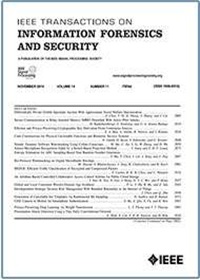Finding Incompatible Blocks for Reliable JPEG Steganalysis
IF 8
1区 计算机科学
Q1 COMPUTER SCIENCE, THEORY & METHODS
IEEE Transactions on Information Forensics and Security
Pub Date : 2024-09-30
DOI:10.1109/TIFS.2024.3470650
引用次数: 0
Abstract
This article presents a refined notion of incompatible JPEG images for a quality factor of 100. It can detect the presence of steganographic schemes embedding in DCT coefficients. We show that, within the JPEG pipeline, the combination of the DCT transform with the quantization function can map several blocks in the pixel domain to the same block in the DCT domain. However, not every DCT block can be obtained: we call those blocks incompatible. In particular, incompatibility can happen when DCT coefficients are manually modified to embed a message. We show that the problem of distinguishing compatible blocks from incompatible ones is an inverse problem with or without solution and we propose two different methods to solve it. The first one is heuristic-based, fast to find a solution if it exists. The second is formulated as an Integer Linear Programming problem and can detect incompatible blocks only for a specific DCT transform in a reasonable amount of time. We show that the probability for a block to become incompatible only relies on the number of modifications. Finally, using the heuristic algorithm we can derive a Likelihood Ratio Test depending on the number of compatible blocks per image to perform steganalysis. We simulate the result of this test and show that it outperforms a deep learning detector e-SRNet for every payload between 0.001 and 0.01 bpp by using only 10% of the blocks from为可靠的 JPEG 隐写分析寻找不兼容块
本文提出了质量系数为 100 的不兼容 JPEG 图像的细化概念。它可以检测到嵌入 DCT 系数的隐写方案的存在。我们表明,在 JPEG 管道中,DCT 变换与量化函数的结合可以将像素域中的多个块映射到 DCT 域中的同一个块。然而,并非每个 DCT 块都能得到:我们称这些块为不兼容块。特别是当 DCT 系数被手动修改以嵌入信息时,不兼容的情况就会发生。我们证明,区分兼容块和不兼容块的问题是一个有解或无解的逆问题,并提出了两种不同的解决方法。第一种方法是启发式的,如果存在解决方案,可以快速找到。第二种方法是整数线性规划问题,能在合理的时间内检测出特定 DCT 变换的不兼容块。我们证明,区块不兼容的概率仅取决于修改的次数。最后,利用启发式算法,我们可以根据每幅图像的兼容区块数量得出一个似然比测试,以执行隐写分析。我们对该测试结果进行了模拟,结果表明,在0.001和0.01 bpp之间的每种有效载荷下,仅使用$\bf 256\times 256$图像中10%的区块,该测试结果就优于深度学习检测器e-SRNet。该测试的 "选择通道感知"(Selection-Channel-Aware)版本更加强大,仅使用了 1%的数据块,就超越了 e-SRNet。
本文章由计算机程序翻译,如有差异,请以英文原文为准。
求助全文
约1分钟内获得全文
求助全文
来源期刊

IEEE Transactions on Information Forensics and Security
工程技术-工程:电子与电气
CiteScore
14.40
自引率
7.40%
发文量
234
审稿时长
6.5 months
期刊介绍:
The IEEE Transactions on Information Forensics and Security covers the sciences, technologies, and applications relating to information forensics, information security, biometrics, surveillance and systems applications that incorporate these features
 求助内容:
求助内容: 应助结果提醒方式:
应助结果提醒方式:


